시속 300㎞ 고속철 , 역에서 서지 않고 승객 내린다 Moving Platforms by Priestmangoode(VIDEO)
고속철 각 역마다 별도의 승하차칸 두고
이 칸을, 달리는 고속철에 도킹하거나 연결
영국, 열차에 접근해 도킹하는 방식 제시
중국, 위에 승하차칸 탑재
By avoiding time-consuming stops, the Moving Platforms concept would allow faster
long-distance journey times.
edited by kcontents
케이콘텐츠 편집
시속 300㎞가 넘는 속도로 질주하는 고속철이 역에서 서지 않은 채 승객을 내리게 하고 태울 수 있을까.
그렇게 하면 정차하는 데 시간이 들지 않을뿐더러 역을 앞두고 서행하고 재출발 후 속도를 최고 수준으로 속도를 끌어올리느라 드는 시간도 절약할 수 있다. 전체 운행시간이 큰 폭 단축된다.
이런 일이 가능해지도록 하는 기발한 아이디어가 제시되고 있다고 최근 기술 전문 매체 테크홀릭이 전했다. 고속철 각 역마다 별도의 승하차칸을 두고 이 칸을 달리는 고속철에 도킹하거나 연결한다는 아이디어다.
영국 디자인 컨설팅 회사 프리스트먼굿(PriestmanGoode)은 고속철 역에서 승하차칸이 열차에 접근한 뒤 도킹해, 열차 승객은 승하차칸으로 옮겨타고 승하차칸 승객은 열차에 타도록 한다는 구상을 내놓았다. 승객 이동이 끝나면 승하차칸은 순환 궤도를 따라 다시 역으로 돌아온다.
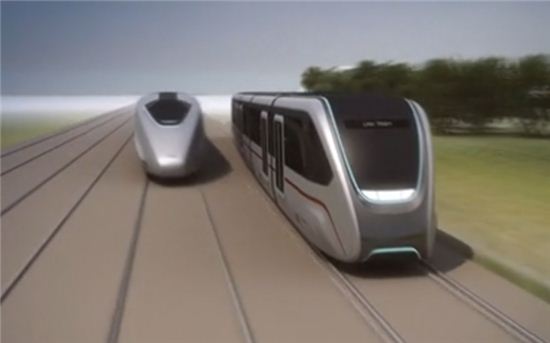
역으로 접근하는 고속철 열차(왼쪽)와 나란히 역에서 출발한 승하차칸이 달리고 있다.

고속철 열차(왼쪽)과 승하차칸이 도킹하고 있다.

승객이 연결된 고속철 열차로 가고 있다.
중국에서는 이보다 간단한 구상이 나왔다. 승하차칸을 열차 윗부분에 연결하는 것이다. 고속철이 역에 접근하면 내릴 사람은 승하차칸으로 올라간다. 역에 있는 승하차칸 안에는 탑승객이 앉아 있다. 열차는 역을 앞두고 승하차칸 연결을 풀어놓는다. 역에서는 새 승하차칸을 싣는다. 열차에서 분리된 승하차칸은 관성에 따라 역으로 미끄러져 온다.
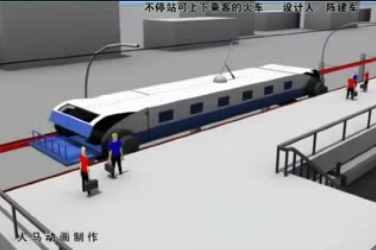
역에서 대기 중인 승하차칸.
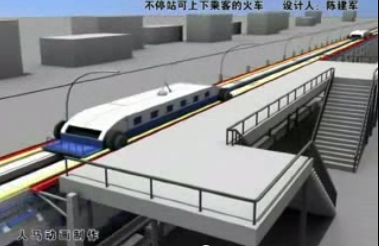
고속철 열차가 승하차칸을 새로 탑재했다. 이 역에서 내릴 승객이 탄 승하차칸은 뒤에 보인다.
중국 방식은 선로를 따로 깔지 않아도 돼 비용이 덜 든다. 그러나 역에서 대기하는 승하차칸이 고속으로 달리는 열차에 탑재되는 과정에서 승객에게 큰 충격이 전해질 수 있다는 문제를 해결해야 한다.
[아시아경제] 백우진 기자 cobalt100@asiae.co.kr
Industrial designers Priestmangoode have revealed a concept for high-speed trains that would transfer passengers to local services while still moving, instead of stopping at stations. Update: this project is included in Dezeen Book of Ideas, which is on sale now for £12.

Trams and local trains would dock alongside the high-speed trains while still in motion, allowing passengers to walk between the two services.
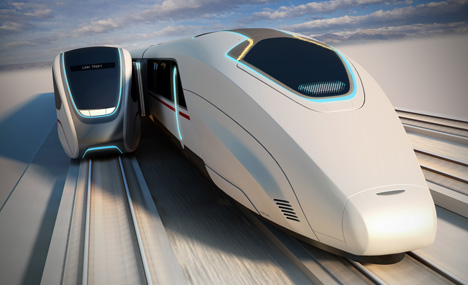
As part of a fully integrated network, passengers would be able to journey from a local stop to any international destination without disembarking.
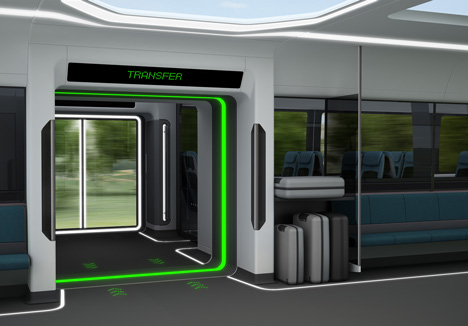
More stories about Priestmangoode on Dezeen »
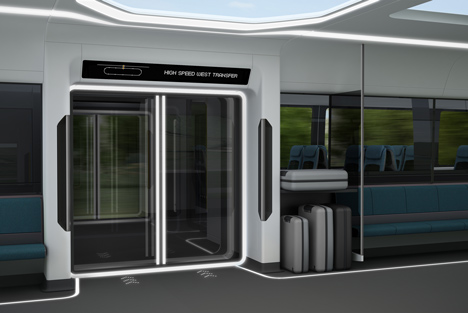
The following details are from Priestmangoode:
Britain’s leading transport designer unveils the future for 21st Century train travel
Britain’s leading transport designer has unveiled his idea for the future of train travel. Moving Platforms is a completely inter-connected rail infrastructure where local trams connect to a network of non-stop high speed trains enabling passengers to travel from their local stop to a local address at their destination (even in another country) without getting off a train.
Paul Priestman of Priestmangoode is the designer of the Virgin Pendolino train and last year’s hugely successful Mercury high speed concept train. Moving Platforms is a totally joined-up network that allows passengers to transfer directly from one moving tram or high speed train to another. This new integrated infrastructure mimics the way the internet works, creating a system similar to the one that allows your home PC to connect to a computer on the other side of the world via a series of connected networks.
Moving Platforms involves a network of high speed trains that run non-stop between two ends of a continent, New York to San Francisco for instance. The high speed trains run on a line that passes outside towns and cities with a network of local feeder trams that carry passengers from local stops out to meet them. As they near each other, the high speed train slows down slightly and the tram speeds up alongside it, at which point the trains physically connect via a docking system allowing passengers to transfer directly across from the tram to the high speed train and vice versa. Once transfers are complete, the trains separate, with the high speed train speeding up again along its route, and the tram slowing down and going back into the town or city centre with the newly disembarked passengers. The tram, in effect, acts as a moving station. The same system could also be used by passengers transferring from one high speed train to another.
This idea is not as crazy as it sounds. There are plenty of examples in every day life where we step onto a moving vehicle: escalators, moving walkways, paternoster lifts, ski lifts and Ferris wheels like the London Eye.
We are trying to build a new 21st Century train service on a station-based infrastructure that was designed in the 19th century for steam trains. We should be re-thinking infrastructure and building an inter-connected local-to-global rail network.
Current plans for high speed rail will require a new network of major stations, taking up huge amounts of space and with a cost and environmental impact that is potentially vast. These stations function for the most part as large car parks that are packed during working hours and empty the rest of the time, and are only in use by passengers for short periods of the day.
The big problem with high speed trains is that they are not very fast. Slowing down and speeding up as they move between stations means they are only able to travel at their full speed for limited periods of time (wasting vast amounts of energy in the process). On long journeys, the non stop high speed train could save a vast proportion of any journey time.
We lose huge amounts of time in transit waiting at stations as we change trains. Moving Platforms would enable passengers to travel from their local stop to an address of their choice in another town or country without getting off a train.
Many rail passengers use cars to get to their main-line embarkation station, so being able to link up to the high speed train directly from a local tram or train service means we could reduce car usage in towns and cities.
Track infrastructure is already in place in many areas. On each train line, there are two tracks, one high speed and one local, next to one another. This means that potentially, Moving Platforms would not take up any more land.
Existing local stations would serve the feeder trams, enabling passengers from rural areas to access the high speed line easily.
Moving Platforms could also be used for local deliveries and freight. This will help get trucks off the road and ease congestion on motorways and in towns and cities.
A journey planner App would tell you what local tram or train to get on in Boston to go to a local address in San Francisco for instance, making travel simpler and easier.
“I can’t believe that across the world we are spending billions on high speed rail making it run on a network that was invented in the 19th Century. I’m under no illusion that Moving Platforms is a big idea, but if we really want high speed rail to be successful and change the way we travel, getting people off the roads and reducing the number of short haul flights, it is imperative that the infrastructure we use works with, not against, this new technology to enable a seamless passenger journey from start to destination. The days of the super-hub train station are over, connectivity is the way forward,” says Paul Priestman.
http://www.dezeen.com/2011/06/22/moving-platforms-by-priestmangoode/
edited by kcontents
"from past to future"
데일리건설뉴스 construction news
콘페이퍼 conpaper
.









